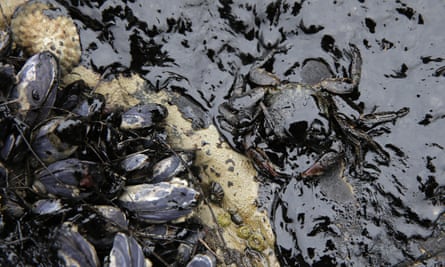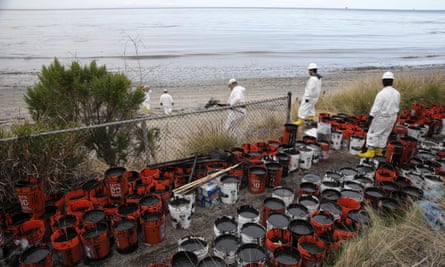A fleet of 18 vessels is battling to contain an oil slick stretching nine miles along the California coast as rescuers on land try to save seals, birds and other wildlife trapped in the black goo.
Crews deployed more than 3,000 feet of boom on Thursday to corral some of the oil which flushed into the Pacific ocean after a pipeline broke on Tuesday, prompting a protest rally and renewed calls for stronger safeguards on oil transport.
Up to 105,000 gallons may have leaked from the ruptured pipeline, with about 21,000 of those gallons reaching the once-pristine waters off Santa Barbara, according to estimates.
California’s governor, Jerry Brown, has declared a state of emergency in Santa Barbara county to cut red tape and facilitate the mobilisation of resources.
The Houston-based company which runs the underground pipeline, Plains All American Pipeline, said on Thursday the 24-inch pipe was carrying 1,300 barrels an hour, below its maximum capacity of 2,000 barrels an hour, when the leak was detected on Tuesday morning.
Federal regulators from the Department of Transportation have yet to determine what caused the 2ft-diameter rupture. It was also unclear how long the leak lasted before detection.

Greg Armstrong, the chief executive of Plains All American Pipeline, apologised during a visit to the site on Wednesday. “We deeply, deeply regret that this incident has occurred at all,” he told a news conference. “We apologise for the damage that it’s done to the wildlife and to the environment.”
Armstrong said the company received permission to continue cleanup operations around the clock and vowed that they “will remain here until everything has been restored to normal”.
Crews have so far extracted 7,770 gallons of oily water from the ocean while on beaches workers in white protective suits shovelled sludge which coated sand, rocks and plants.
The cleanup could last months, officials said. Currents, tides and winds make the oil slick “a moving target” as it drifts offshore, coast guard captain Jennifer Williams told reporters.
The environmental impact still is being assessed but so far harm to wildlife appears limited. Lobster and species of marine invertebrates have been found dead and there have been dramatic images of oil-coated seals and birds.
Mark Crossland, a captain with the California department of fish and wildlife, said five pelicans were rescued and taken to a facility in Santa Barbara.
Officials closed fishing and shellfish harvesting for a mile east and west of Refugio beach and deployed booms to protect the nesting and foraging habitat of the snowy plover and the least tern, both endangered shore birds.
The coastal area is habitat for seals, sea lions and whales, which are now migrating north through the area.

Dozens of protesters staged a rally on the Santa Barbara courthouse lawn on Thursday, some brandishing placards that said “get oil out” and “moratorium now: no new drilling”.
At a rally in the Santa Barbara Courthouse Sunken Garden on Thursday, more than 100 protestors staged a rally, shouting “No more!” as one speaker after another denounced the oil industry as inherently dangerous and risky.
Mike Lyons, president of Get Oil Out! reminded an audience of residents and reporters that the All-American oil pipeline that burst this week at Refugio was built in response to local opposition to the transportation of oil by tankers through the Santa Barbara Channel. Pipelines on land, it was argued, would be a safer alternative to shipping a hazardous substance by sea.
“No matter how good the technology, as long as there is oil development there will be spills again and again and again,” Lyons said. Get Oil Out! was formed in 1969, after the disastrous blowout of an oil platform in the channel.
On Thursday, rally participants held up signs that read: “Again. Seriously?” “Fossil Fuels: Dumb and Dumber,” “One Slick Too Many, ” and “Solar Won’t Spill.” They called on Brown to ban oil fracking on- and offshore, and expressed their support for federal legislation, sponsored by US congressman Lois Capps, a Democrat from Santa Barbara, that would ban exploration and drilling for new oil and gas off the California coast.
Santa Barbara Mayor Helene Schneider and Salud Carbajal, a Santa Barbara County supervisor who serves on the US Environmental Protection Agency’s local government advisory committee, called the Refugio spill “devastating” and a “major disaster for our environment and our economy.” Amid loud applause, Schneider vowed to “create the local will to get off fossil fuels once and for all.”
California’s lieutenant governor, Gavin Newsom, called for a review of all state oil contracts, and particular scrutiny for Plains All American Pipeline.
“This company will be held to the account that it’s responsible, but first and foremost, it’s about cleanup and mitigation, and addressing the longer-term risks and assessing our other pipes throughout the state.”
The Santa Barbara County district attorney, Joyce Dudley, said her office, along with the state attorney general, was investigating the spill for possible criminal prosecution or a finding of civil liability.
Plains All American Pipeline said the pipeline, built in 1991, had no previous problems and was thoroughly inspected in 2012. It was tested again about two weeks ago but the results have not yet been analysed.

The Los Angeles Times reported that according to federal records the Texas company has since 2006 accumulated 175 safety and maintenance infractions, including pump failure, equipment malfunction, pipeline corrosion and operator error.
The grim spectacle of blackened beaches and the acrid smell of petroleum prompted officials to close Refugio state beach and El Capitan state beach over Memorial Day weekend.
Some tourists pulled off the Pacific Coast Highway and viewed the scene from bluffs.
“It smells like what they use to pave the roads,” Fan Yang, of Indianapolis, told AP. “I’m sad for the birds if they lose their habitat.”
This stretch of coast was the scene of a much bigger, disastrous spill in 1969, the largest in US waters at the time, which fuelled the rise of the environmental movement.
Comments (…)
Sign in or create your Guardian account to join the discussion